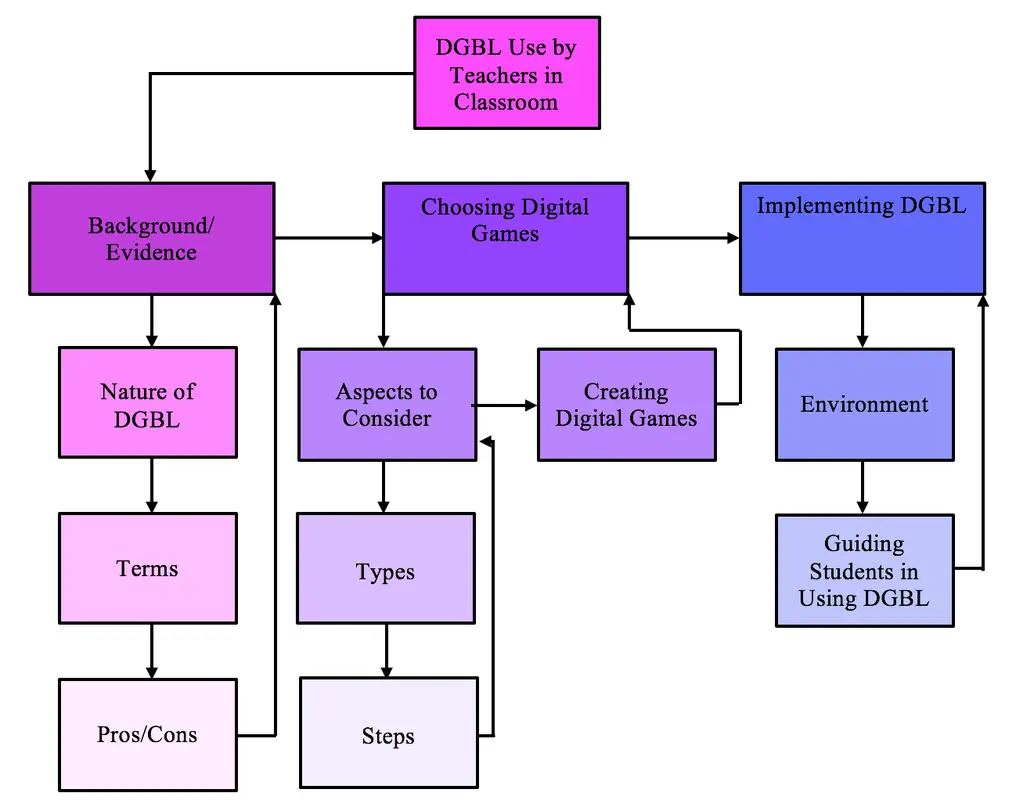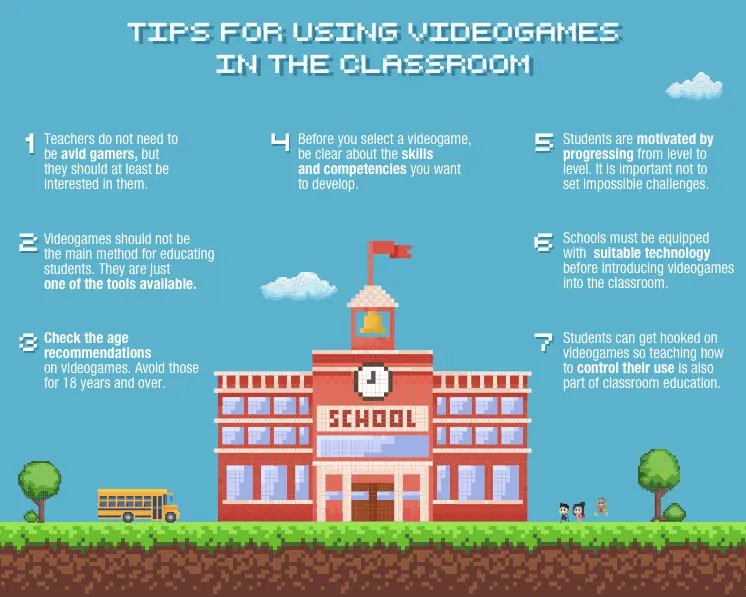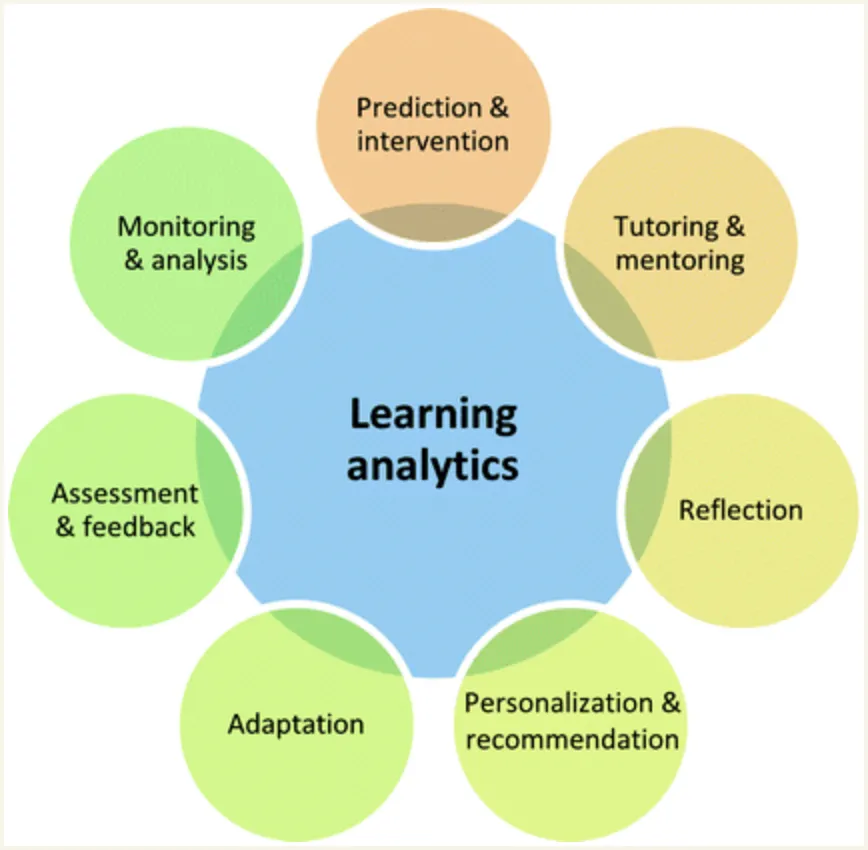5. Teacher guide
Learning Objectives
- How to setup a DGBL session
- What skills a teacher needs to develop
- What challenges are there in DGBL?
- What hardware do we need and how to set it up?
- What Skills does student needs to start?
- How to assess the outcome of a VG
- What are game analytics?
- What to assess?
How to use EVG in Classroom
After learning about the benefits of educational video games and the characteristics of a good educational video game, we arrive at the question: how do we incorporate game-based learning for maximum benefit as well as when and where in the curriculum? Also, what about class management, how do we manage the environment of the class and students while playing the game?
In this unit, we will answer all these questions and provide a guideline and tips that instructors can follow when deciding to select and implement an educational video game.
📽 #VIDEO Using Games in the Classroom
Teacher 2.0
With the infusion of technology in the classroom, teachers are moving away from being sole presenters of information and are moving into the new roles of bring "facilitators". With this new role comes the excitement of presenting digital game-based learning to students that has been proven to increase students' desire to learn, lower their stress levels and provide new, proactive ways of learning needed 21st century skills. Furthermore, teachers/facilitators can rely on "new evaluation tools" that are rubric-like and can be used to evaluate and determine whether games will engage their students while teaching them. In conclusion, when teachers properly evaluate games to ascertain their usability in the classroom and then implement them correctly, they bring a new level of learning into the classroom that reinvigorates students' desire to learn while decreasing unwanted stress that inhibits those students' ability to excel.

Approach
The approach to Digital Game-Based Learning needs to be well planned and organized to engage in learning and to produce the appropriate outcomes.
The coaches must learn to set the stage, providing relevant game information and support the students in their attempts to construct, deconstruct and reconstruct relevant forms of knowledge (both in relation to the game context, curricular goals and real life phenomena).
They must become familiar with the theoretical underpinnings of DGBL, learn about the specific games they will be using: techniques, gameplay, curriculum, outcomes, assistance, evaluation. For all that, we’ll provide a list of digital learning games as case studies for the coaches.
It is important to know the theory and the tools because games do not work by themselves and not all refugees/adults/coaches are comfortable with digital games.
Tips for using VG in the classroom

Must
- Teachers do not need to be avid gamers, but they should at least be interested in them.
- Videogames should not be the main method for educating students. They are just one of the tools available.
- Check the age recommendations on videogames. Avoid those for 18 ears and over.
- Before you select a videogame, be clear about the skills and competencies you want to develop.
- Students are motivated by progressing from level to level. It Is Important not to set impossible challenges.
- Schools must be equipped with suitable technology before Introducing videogames into the classroom.
- Students can get hooked on videogames so teaching how to control their use is also part of classroom education.
Plus
- The educator should play the game prior to the intervention, in order to identify its possible limitations.
- The educator should adapt the game according to the educational scenario and correlate it with the traditional methods of teaching.
- The gaming intervention should have a specific time limit that should not be altered.
- During the gaming intervention the educator should first play with the students in order to make sure they understand the game and are able to proceed on their own, and afterwards supervise the students and associate the gaming content with educational goals.
- The educator should ask feedback from the students after the intervention and take into account their considerations and preferences for the design of next GBL experiences.
A Digital Game Based Learning session
We can summarise a DGBL session in these five steps:
1. Introduction to videogame
The teacher explains the game and helps installing it on the students devices. Then tells the outcomes expected from playing this game.
2. gameplay / experience
autonomous activity: the student becomes player
3. game results / scores
autonomous activity: the player finish to play. check the score
4. reflection / analysis
student and the teacher analyse together the outcome
5. forming abstract concepts + real world application
Teacher Skills
The teacher has to develop or at least know something about these topics:
- ICT / Basic Digital Skills
- Minimal game playing experience
- Deep understanding of how a game can help learning and its differences with a classic book/course
- Recognise different players skills and support their game play
- Engage students in playing and progression
Challenges
There could be some difficulties and challenges to be solved in order to achieve better results in DGBL sessions.
Curriculum: it’s hard to find games that fit the current curriculum or to identify how a certain game can connect to the curriculum. Check out commonsense.org/education for ideas. Remember that the best way to use games is as a supplemental reinforcement for your traditional teaching. Don’t look for games that will teach your curriculum. Instead, look for games that might approach the same subject area from a different perspective.
Game related: identify the accuracy and appropriateness of the content of the game. Irrelevant or distracting content from the game that could not be removed.
Attitudes: persuading all stakeholders and non-players about the educational value of the game.
Educators and Teachers support: make them aware of how to use games more effectively in education.
Technology many teacher are unfamiliar with technology. That’s okay. Most of the writing about game-based learning focuses on digital media, but the truth is that you don’t necessarily need devices. At the Quest To Learn school in New York City, game design is a way of thinking, a paradigm. A great deal of their curriculum uses paper-based games rather than digital games.
Assessment: Traditional assessments do not often align with GBL, so new models and approaches must be considered.
Developers encourage and support game developers in the creation of better educational games
Moderation
The impact of video games on society has been the subject of numerous studies. For example a psychologist at the Internet Institute at Oxford University, published a study establishing how much time should children be allowed to devote to video gaming. He reports that those who played less than an hour were more emotionally stable, while those who played for around three hours a day developed social problems. Therefore, when it comes to video games, moderation is key.
How to implement GBL?
There are many strategies and ways for educators to incorporate game-based learning and EVGs into their curriculum and classroom. Here are three ways that teachers can follow to implement game-based learning:
Games as shared Experience
The EVGs selected plays more on experience, giving students the feel of being on a field trip. Like a field trip, students are first given instructions on what to expect and are then given freedom to explore an out-of-school location. And then back in the classroom, instructors facilitate and emphasize the connections of the game to the curriculum. These games, provide meaning for students. For example in MineCraft students build structures and “When night comes and creepers attack, only the students who stayed in fortified structures survive. After play, we discuss the difficulties of setting up a colony in a hostile environment. Students understand the dangers of settling new worlds because they have experienced them”.
Games as Text
These games allow users to decide the fate of the game. The game is built on a template uses player choice to tell a story. These include Examples include Firewatch, an open-world game about being a park ranger; Life Is Strange, an emotional tale of friendships and bullying at a private school; Her Story, a nonlinear, police procedural whodunit; and 1979 Revolution: Black Friday, a political thriller set in the Iranian Revolution. Each game tells a story. Assessing learning with these games, educators can use Office 365 or Google Docs. For example, English literature teacher Paul Darvasi has his students play the point-and-click exploration game Gone Home, which is about a dysfunctional family. Set in 1995, the game uses literary devices like mood, tone, and theme. He has students take screenshots as evidence and add them to a shared document. Collected screenshots later lead to projects like comparing reviews and then writing their own.
Games as Models
These games are built on model real-world systems. They give students the opportunity to create their own models within the game. A teacher states that he makes students play Werewolf, and discuss “different actions that mirror the events of the Salem witch trials, McCarthyism, and other witch hunts. I also have students play the board game Pandemic, as well as the mobile game Plague, Inc. These games illustrate how diseases travel the interconnected networks of the world. Students learn how the bubonic plague traveled along the Silk Road.”. He states that these games model causes that have effects, which subsequently have effects that teaches the 21st-century skill of systems thinking.
Other tools
Teachers also can create their own form of EVGs by creating learning games in Google Classroom
Students pre-evaluation and setup
Setup device
Install the game on the device and run it once. If needed do some Android tuning (notifications, for example)
Assessment of Learning from Digital Games
The way in which any game is assessed is crucial if it is to be purposeful, to be seen as appropriate by the students and to encourage them to engage in the learning experience. There are seven aspects that should be examined when determining the effectiveness of game-based learning.
- Learner performance - whether learning has taken place and there is an improvement in learner performance.
- Motivation – the levels of student motivation, interest and participation in the game.
- Perceptions - the views of the students towards areas such as the experience of time passing, the realism of the game, amounts of complexity, support received and levels of perceived proficiency within the game.
- Attitudes - feelings of the learners and teachers towards the subject itself and the use of games for learning within that subject.
- Collaboration - the regularity and effectiveness of collaboration. (Connolly et al. argue that this is optional and dependent on the game design; I would argue that in the context of adult learning with games collaboration is an important part of the learning design.)
- Preferences - inclinations of the learners and teachers towards, for example, different learning styles or modes of interaction.
- Game-Based Learning Environment - factors associated with the game itself, such as the design of the environment, use of scaffolding, usability, levels of social presence and the way in which the game is deployed.
Evaluation Tools: Analytics
The analysts part is the more important

Engagement Survey
This questionnaire can be used after an activity has been completed to evaluate the level of engagement relative to another activity. In order to analyse the results and compare levels of engagement between two different activities the following steps should be taken.
- Allocate a value to each answer, where strongly disagree = -2 to strongly agree = 2
- For negative items (e.g. ‘I could not tell what effect my actions had’) reverse this scale.
- Add up the total points to get a value for engagement with the activity.
Thinking about the activity you have just undertaken, please indicate the level to which you agree with the following statements:
Strongly Disagree (-2) | Disagree (-1) | Neither agree nor disagree (0) | Agree (1) | Strongly Agree (2)
- I wanted to complete the activity
- I found the activity frustrating
- I felt that I could achieve the goal of the activity
- I knew what I had to do to complete the activity
- I found the activity boring
- It wasn’t clear what I could and couldn’t do
- It was clear what I could learn from the activity
- I felt absorbed in the activity
- The activity was pointless
- I was not interested in exploring the options available
- I did not care how the activity ended
- I felt that time passed quickly
- I found the activity satisfying
- The activity would not let me do what I wanted
- I could not tell what effect my actions had
- I did not enjoy the activity
- Feedback I was given was useful
- I found it easy to get started
Unit Review
- At the end.. what do you think about DGBL?
- What do you think is the best attitude using games in classroom?
- What do you need to improve your teaching sessions?
- Are you going to play more videogames from tomorrow?
- Did you like this course?
- Did you learn something new?
- What did you like most?
- Have you some suggestion to improve this course?